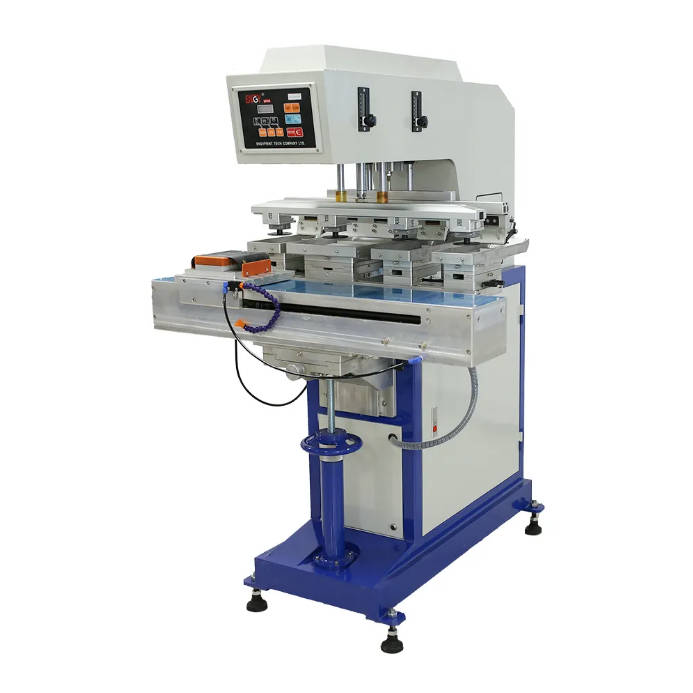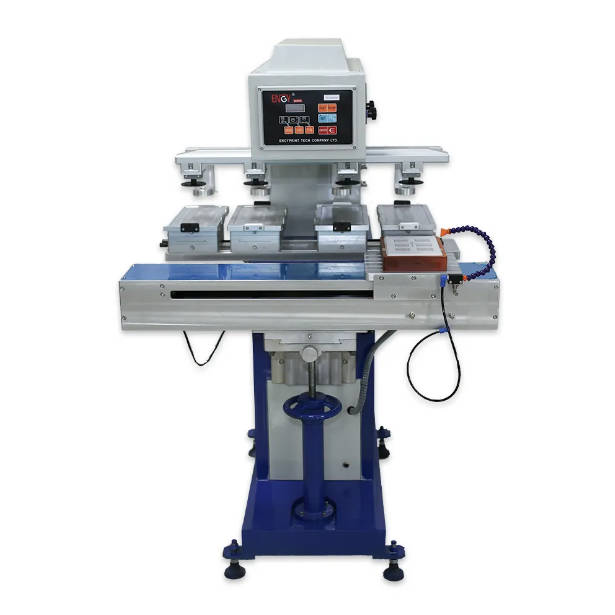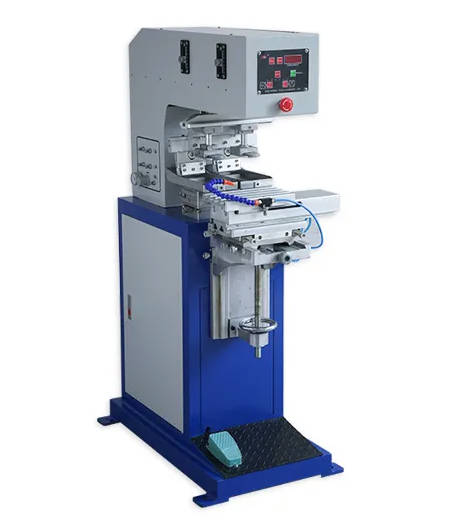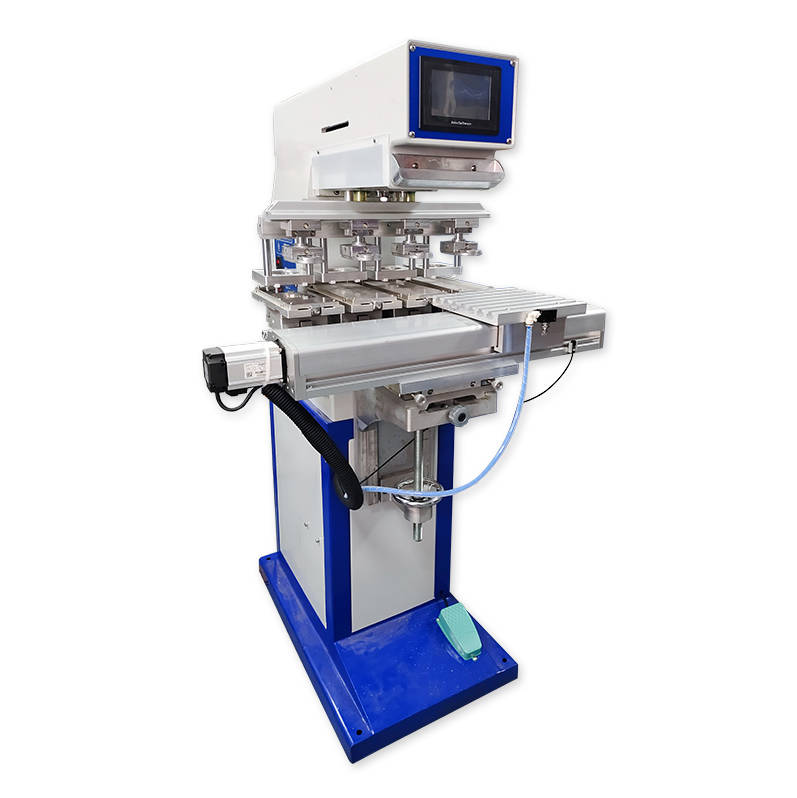Introduction
In the vast landscape of modern manufacturing and product decoration, few technologies offer the versatility and precision of pad printing. From branding the intricate curves of a medical device to printing logos on promotional golf balls, pad printing provides a robust solution for applying high-quality images to three-dimensional, irregular surfaces. This unique capability has cemented its importance across a multitude of industries, including electronics, automotive parts, toys, apparel, and medical equipment. The core strength of the technology lies in its ability to conform to almost any shape—concave, convex, textured, or flat—making it the go-to method where other printing techniques like screen printing or digital printing fall short.
However, for a business looking to integrate this technology, the path forward is not always clear. The market is populated with a wide spectrum of machinery, ranging from simple, manually operated desktop units to sophisticated, fully automated industrial systems integrated into high-speed production lines. The primary deciding factor often boils down to cost versus capability. This article aims to demystify this choice by providing a comprehensive cost comparison between entry-level and industrial-grade pad printing systems. We will delve into the features, operational expenses, and overall return on investment for each category, empowering potential buyers to make a strategic and informed decision.
While entry-level machines present an affordable gateway into pad printing for small-scale operations, startups, and R&D labs, industrial-grade systems are engineered for the relentless demands of high-volume, high-precision manufacturing. The ultimate choice is not merely about the initial price tag; it is a strategic decision that hinges on specific production requirements, desired print quality, labor costs, and long-term scalability. This guide will navigate these complexities, ensuring your investment aligns perfectly with your business goals.

Understanding Pad Printing Machines
Before diving into a cost analysis, it’s essential to grasp the fundamental principles of the pad printing process and the key components that constitute a machine. This foundational knowledge is crucial for appreciating the differences in cost and performance between entry-level and industrial systems.
The Pad Printing Process Explained
Pad printing, also known as tampography, is an indirect offset gravure printing process that involves transferring a 2D image from an etched plate (cliché) onto a 3D object via a flexible silicone pad. The magic of the process lies in the unique properties of the silicone pad, which can adapt to a vast array of surface shapes, and the solvent-based inks, which become tacky upon exposure to air, allowing them to adhere first to the pad and then to the final product (substrate).
The cycle can be broken down into a few simple steps:
- Inking: An ink cup (in a closed system) or a flood bar (in an open system) moves over the etched plate, filling the engraved image area with ink.
- Doctoring: The sharp edge of the ink cup ring or a doctor blade scrapes across the plate, removing excess ink and leaving ink only in the etched cavity. The top layer of this ink becomes tacky as the solvent evaporates.
- Image Pickup: The silicone pad presses down onto the etched plate, compressing and rolling slightly to pick up the tacky ink from the etch.
- Image Transfer: The pad then moves over to the substrate and presses down, transferring the ink layer onto the object. The pad’s soft, flexible nature allows it to wrap around curved or uneven surfaces for a complete transfer.
- Cycle Repeat: The pad lifts, returning to its home position to begin the next cycle.
Key Components of a Pad Printer
Understanding the core components helps clarify where the costs and complexities arise in more advanced machines.
- Plates (Clichés): These are the masters from which the image is transferred. They are typically made of photopolymer or steel and are chemically etched or laser-engraved with the desired artwork. Steel plates are more expensive but offer extreme durability for millions of impressions, making them suitable for industrial use. Polymer plates are cheaper and easier to make in-house, ideal for short runs and entry-level applications.
- Silicone Pads: The heart of the process, these pads come in a wide variety of shapes, sizes, and durometers (hardness levels). The choice of pad depends on the image size, the shape of the substrate, and the surface texture. A harder pad offers better image definition, while a softer pad conforms better to highly irregular surfaces.
- Ink Systems: There are two primary types of ink systems.
- Open Inkwell System: An older technology where ink is held in an open trough. A flood bar pushes ink over the plate, and a doctor blade removes the excess. This system is less expensive but exposes the ink to air, causing rapid solvent evaporation and changes in viscosity, requiring more operator attention.
- Sealed Ink Cup System: The modern standard. This system uses an inverted cup with a sharp, polished ceramic or metal ring that acts as both the ink reservoir and the doctor blade. It slides over the plate, leaving ink in the etch while keeping the main ink supply sealed from the air. A sealed ink cup system significantly reduces solvent consumption and emissions by up to 95% and provides much more consistent ink viscosity, leading to higher print quality.
- Machine Types: Pad printers are generally categorized by their level of automation: manual, semi-automatic, and fully automatic. These categories align closely with the entry-level versus industrial-grade distinction.
Common Applications
The versatility of pad printing is evident in its widespread use:
- Promotional Products: Pens, keychains, USB drives, stress balls, and golf balls.
- Electronics: Keyboard keys, circuit breaker markings, logos on casings, and internal components.
- Medical and Pharmaceutical: Catheters, syringes, surgical instruments, and dosage markings on pills.
- Automotive: Dashboard buttons, control knobs, engine components, and indicator markings.
- Toys and Apparel: Logos on action figures, designs on toy cars, and tagless size labels on clothing.
Entry-Level Pad Printing Machines
Entry-level pad printing machines are the workhorses for small businesses, startups, promotional product distributors, and in-house prototyping labs. They are designed for affordability, ease of use, and flexibility in low-volume production environments.
Definition and Key Features
Entry-level systems are typically 1-color or 2-color manual or semi-automatic machines designed for low-to-medium volume production runs. They prioritize a low initial investment over high-speed automation and are perfect for operations where jobs change frequently and production quantities are manageable.
Key features include:
- Basic Automation: Most are pneumatically powered (requiring an air compressor) and operated by a foot pedal or dual push buttons for safety. Manual machines, operated by a hand lever, exist at the very lowest end of the price spectrum.
- Limited Color Capability: The vast majority are single-color machines. Two-color models are available but often require the part to be manually moved between pads or use a shuttle system, which slows down the process.
- Compact Footprint: They are often designed as benchtop units, making them ideal for workshops or small production floors where space is at a premium.
- Lower Precision: While capable of producing high-quality prints, they lack the micro-adjustments and rigid construction of industrial machines, making ultra-high-precision registration for multi-color jobs more challenging.
- Moderate Print Speeds: A typical operator can achieve speeds of 500 to 1,000 cycles per hour on a semi-automatic machine. Actual output depends heavily on the operator’s speed in loading and unloading parts.
- Simple Substrates and Images: They excel at printing smaller logos and text on relatively simple parts. While capable of handling curves, they may struggle with extremely complex geometries without custom fixtures.
Cost Breakdown
The financial accessibility of entry-level machines is their biggest selling point.
- Initial Purchase Price: A good quality, semi-automatic, single-color benchtop pad printer from a reputable manufacturer typically costs between $3,000 and $10,000. This price usually includes a starter kit with a sealed ink cup, a pad, and a blank plate. Cheaper, often lower-quality, manual machines can be found for under $1,000, but they are generally not recommended for business use due to a lack of support and durability.
- Ongoing Costs:
- Labor: This is the most significant ongoing cost. Since the machine is semi-automatic, an operator must be present to load and unload every single part.
- Consumables: Ink and solvent costs are relatively low. Pads need to be replaced periodically, with a typical pad lasting 50,000 to 100,000 impressions. The per-print cost for a pad is often fractions of a cent, around $0.0015 per print.
- Maintenance: Maintenance is minimal and can usually be performed by the operator. It involves routine cleaning and occasional replacement of the ink cup’s ceramic ring.
- Accessories:
- Plates (Clichés): Photopolymer plates are common and cost between $50 and $200 each to be professionally etched. In-house platemaking systems are also an option.
- Pads: A standard pad costs around $75 on average, with prices varying based on size and complexity.
- Inks: Pad printing ink costs between $20 and $50 per liter, depending on the type and color.
- Fixtures (Jigs): A custom fixture to hold the part securely during printing is often necessary and can range from a simple, self-made jig to a professionally machined one costing several hundred dollars.
Pros and Cons of Entry-Level Systems
Pros:
- Low Initial Investment: The affordable entry point lowers the barrier for small businesses to bring printing capabilities in-house.
- Flexibility: Quick and easy to set up for different jobs, making them ideal for short runs and diverse product lines.
- Short Learning Curve: Operators can be trained to use the machines effectively in a matter of hours.
- Space-Efficient: Their small, benchtop design fits easily into most workspaces.
- Versatile Material Handling: Can print on a wide range of materials with the correct ink and pre-treatment.
Cons:
- Low Production Speed: Output is entirely dependent on operator speed and cannot match automated systems.
- Inconsistent Quality in High Volumes: Operator fatigue can lead to inconsistencies in print placement and quality over long runs.
- Higher Labor Costs: The per-piece labor cost can be high, making it uneconomical for very large production volumes.
- Limited Scalability: The machine’s output is capped, meaning a significant increase in demand would require purchasing additional machines and hiring more operators.
- Not Ideal for Complex Multi-Color Prints: Achieving tight registration on 3+ color jobs is difficult and time-consuming.
Industrial-Grade Pad Printing Machines
Industrial-grade pad printing machines represent the pinnacle of the technology. They are built for speed, precision, and endurance, designed to operate continuously in demanding, high-volume manufacturing environments.
Definition and Key Features
Industrial-grade systems are fully automated, high-precision machines designed for large-scale, continuous production. They often feature multiple colors and are engineered for integration into larger automated assembly lines. These machines minimize human intervention to maximize output and ensure absolute consistency.
Key features include:
- Advanced Automation: These machines go far beyond simple pneumatics. They often use servo-driven motors for precise, programmable control over every movement. This allows for fine-tuning of pad compression, speed, and positioning, resulting in superior print quality. Automation extends to part handling, with options like rotary tables, linear shuttles, and robotic pick-and-place systems.
- High Multi-Color Capability: Industrial machines are commonly configured for 4, 5, or even 6-color printing. They achieve perfect registration between colors through highly rigid construction and precise part indexing systems.
- High-Speed Operation: With automated part feeding and ejection, these systems can achieve speeds of up to 3,000+ cycles per hour, and sometimes even more on specialized equipment.
- Enhanced Durability and Reliability: Built with heavy-duty components, they are designed for 24/7 operation with minimal downtime. They often include features like job recipe recall, production monitoring, and remote diagnostics.
- Integrated Pre- and Post-Treatment: Many systems can be configured with integrated stations for pre-treatment (like flame, corona, or plasma to improve ink adhesion on difficult plastics) and post-treatment (like UV or heat curing systems to instantly dry the ink).
- Quality Control Features: Advanced systems may incorporate machine vision cameras to inspect each print for defects in real-time, automatically rejecting any faulty parts.
Cost Breakdown
The investment for an industrial system is substantially higher, reflecting its advanced capabilities and robust construction.
- Initial Purchase Price: A multi-color industrial pad printing system typically starts at $20,000 and can easily exceed $50,000 or even $100,000 for highly customized or complex solutions. A machine with a rotary table, for example, adds significant cost due to the complex feeding and indexing mechanisms.
- Ongoing Costs:
- Labor: While direct operator labor per piece is drastically reduced or eliminated, there is a higher cost for skilled technicians to set up, program, and maintain the machine.
- Maintenance: More complex systems require more intensive and costly preventative maintenance. Service contracts from the manufacturer are common.
- Utilities: The energy consumption of servo motors, dryers, and control systems is higher than that of a simple pneumatic machine.
- Accessories and Integration:
- Custom Tooling and Fixtures: Automation requires highly precise, custom-engineered fixtures and part nests, which can cost $5,000 or more.
- Ancillary Equipment: Costs for conveyors, part feeders, vision systems, and safety guarding must be factored in.
- Installation and Training: Professional installation and comprehensive operator/maintenance training are essential and are often a separate line item on the purchase order.
Pros and Cons of Industrial-Grade Systems
Pros:
- High Efficiency and Output: Massively increased throughput leads to a very low per-piece printing cost in high volumes.
- Superior Print Quality and Repeatability: Automation eliminates human error, ensuring every print is identical.
- Reduced Labor Costs: Frees up personnel from the monotonous task of loading/unloading parts, allowing them to focus on more value-added activities.
- Versatility for Complex Jobs: Can handle intricate, multi-color designs with tight tolerances that are impossible on entry-level equipment.
- Long-Term Durability: Built to last for decades in an industrial setting.
Cons:
- High Upfront Investment: The significant initial capital outlay can be a barrier for many businesses.
- Requires Skilled Operators: Setup and troubleshooting require a higher level of technical expertise.
- Larger Footprint: These machines and their associated automation systems require significant floor space.
- Longer Changeover Times: Switching between jobs is more involved and time-consuming compared to a simple benchtop machine.
- Potential Overkill for Small Runs: The high cost and complex setup are not justifiable for low-volume or high-mix production.
V. Direct Cost Comparison
To make an informed decision, it’s helpful to see the costs side-by-side. The following table provides a clear visualization of the financial differences, followed by an analysis of the total cost of ownership.
| Aspect | Entry-Level Systems | Industrial-Grade Systems |
| Initial Cost | $3,000 – $10,000 | $20,000 – $50,000+ |
| Per-Print Cost (Consumables) | ~$0.0015 (Pad Wear) | ~$0.0015 (Pad Wear) |
| Primary Operating Cost | Manual Labor (Operator per machine) | Automation, Skilled Technicians |
| Ideal Daily Volume | Suitable for < 1,000 units/day | Ideal for > 5,000 units/day |
| Job Changeover Time | 10-20 minutes | 1-3 hours |
| Total Ownership Cost (1 Year) | $5,000 – $15,000 (incl. supplies) | $30,000 – $70,000 (incl. efficiency gains) |
Analysis: Beyond the Sticker Price
The table clearly shows a stark difference in initial investment, but this is only part of the story. The true financial impact is revealed when analyzing the Total Cost of Ownership (TCO) and Return on Investment (ROI).
For an entry-level machine, the largest component of TCO over time is labor. If an operator earning $15/hour can produce 500 parts per hour, the labor cost alone is $0.03 per part. For a run of 100,000 parts, that’s $3,000 in labor.
For an industrial machine, the upfront cost is high, but the per-piece labor cost is negligible. Let’s say the same 100,000-part run can be completed in 33 hours on a machine running at 3,000 parts per hour. The machine can run largely unattended, drastically reducing the labor cost associated with that run.
The break-even point is critical. A business must calculate the production volume at which the savings in labor from an industrial machine surpass its higher initial cost. If a company’s production needs are consistently high, the ROI on an industrial system can be realized surprisingly quickly, often within 12 to 24 months, through sheer productivity gains and labor reduction. Conversely, for a business with sporadic, low-volume needs, an industrial machine would never reach its break-even point and would be a poor financial decision.
Factors to Consider When Choosing
Choosing the right pad printing machine is a strategic decision that requires a thorough evaluation of your business needs. Here are the key factors to consider.
1. Production Volume
This is the most critical factor. Be realistic about your current and future needs.
- Low Volume (< 1,000 parts/day): If you are running small batches, prototypes, or have infrequent printing needs, an entry-level machine is the logical and most cost-effective choice.
- High Volume (> 5,000 parts/day): If you are engaged in mass production and printing is a daily, continuous process, the speed and automation of an industrial-grade system are essential to remain competitive.
2. Budget and ROI
Assess your capital budget not just for the machine, but for the entire ecosystem.
- Calculate TCO: Factor in the initial price, installation, training, labor, consumables, maintenance, and utilities.
- Analyze ROI: For an industrial machine, calculate how long it will take for labor savings and increased output to pay for the initial investment. For an entry-level machine, the ROI is often about bringing a previously outsourced service in-house, giving you more control and faster turnaround times.
3. Precision and Quality Requirements
The complexity of your artwork and the quality standards you must meet are paramount.
- Single-Color Logos: Most entry-level machines can handle this with ease.
- Tight-Registration Multi-Color: If your product requires printing multiple colors with very tight tolerances (common in medical and electronics), the precision and stability of an industrial, servo-driven machine are non-negotiable.
4. Space and Setup
Consider your physical plant and infrastructure.
- Limited Space: A compact, benchtop entry-level machine can fit almost anywhere.
- Dedicated Area: An industrial system with conveyors, feeders, and safety guarding may require a significant, dedicated area on your production floor. You also need to account for utilities like compressed air and three-phase power.
5. Material and Image Complexity
Consider the products you are printing on.
- Substrate: Are you printing on easy-to-print materials like ABS plastic, or difficult ones like polypropylene or silicone that require pre-treatment? Industrial systems can more easily integrate pre-treatment stations.
- Image Size and Shape: Larger images may require larger, more robust industrial machines. Printing on a highly complex, multi-faceted object may necessitate a custom-engineered automation solution.
6. Supplier Support and Training
A machine is only as good as the support behind it.
- Warranty and Service: Evaluate the supplier’s warranty, technical support availability, and the cost of service contracts.
- Training: Ensure the supplier provides comprehensive training for both operators and maintenance staff. This is especially critical for complex industrial systems.
- Parts Availability: Confirm that spare parts like pads, rings, and plates are readily available to minimize potential downtime.
7. Scalability
Think about your business’s future growth.
- Starting Small: It is a common and viable strategy to start with an entry-level machine. As your business grows and volume increases, you can add more entry-level machines or use the experience gained to confidently invest in an industrial system.
- Future-Proofing: If you anticipate rapid growth, investing in a modular industrial system that can be expanded later might be a wise long-term decision.
Addressing Common Questions from Potential Buyers (FAQ)
What is the maximum image size and color limit?
For entry-level machines, the practical limit is typically a small logo or text, usually under 3-4 inches in diameter, in 1 or 2 colors. For industrial machines, the possibilities are much greater, with capabilities for large images and up to 6 or more colors with precise registration.
How long does the ink take to dry and what substrates can it work on?
Most solvent-based pad printing inks are touch-dry within 10-30 seconds, allowing for immediate handling or printing of a second color. Full chemical curing can take anywhere from a few hours to 24 hours. With the correct ink series and any necessary pre-treatment (like flame treatment for polyolefins), pad printing works on nearly any material, including plastics, metals, glass, ceramics, wood, and painted surfaces.
Manual vs. Automatic: Which is better?
This depends entirely on volume and budget. Manual is the absolute lowest-cost entry point, suitable for hobbyists or extremely low quantities, but it is labor-intensive and inconsistent. Semi-automatic is the standard for small businesses, offering a good balance of cost and efficiency. Fully automatic (industrial) is necessary for high-volume manufacturing where labor reduction and speed are the primary goals.
What is the maintenance and durability like?
Entry-level machines are durable for their intended use but will show wear faster under heavy, continuous operation. Maintenance is simple (cleaning, occasional part replacement). Industrial machines are built for extreme durability with heavy-duty components designed for millions of cycles. They require a more structured, preventative maintenance schedule that may need professional servicing.
Is pad printing cost-effective for small batches?
Yes, using an entry-level machine for small batches is highly cost-effective. The quick setup allows businesses to print custom jobs on-demand without the high costs associated with outsourcing. An industrial machine, however, is generally not cost-effective for small batches due to its long setup time and high operating cost.
What are the environmental and safety factors?
Modern sealed ink cup systems, used on both entry-level and industrial machines, dramatically reduce the emission of volatile organic compounds (VOCs) compared to old open inkwell systems. This makes the workplace safer and reduces solvent consumption. Industrial systems may be integrated with better ventilation and air purification systems as part of a larger plant safety protocol.
Conclusion
The choice between an entry-level and an industrial-grade pad printing machine is a pivotal one, with significant implications for a company’s production efficiency, product quality, and bottom line. The decision should not be driven by the initial purchase price alone, but by a holistic assessment of your specific operational needs.
To recap the key differences: entry-level machines offer an affordable, flexible, and user-friendly solution for businesses with low-to-medium production volumes, frequent job changes, and limited budgets. They empower small companies to control their product decoration process, reduce outsourcing costs, and improve turnaround times. In contrast, industrial-grade systems are precision-engineered for the rigorous demands of high-volume manufacturing, delivering unparalleled speed, consistency, and automation. They are a significant capital investment that pays dividends through drastically reduced labor costs and massive throughput, making them the cornerstone of large-scale production lines.
Ultimately, the right machine is the one that aligns with your business strategy. Carefully evaluate your production volume, quality requirements, budget, and long-term growth plans. We strongly recommend consulting with reputable equipment suppliers, requesting demonstrations, and even sending them samples of your parts to print. A thorough due diligence process will ensure that your investment in pad printing technology is not just a purchase, but a strategic step towards enhancing your product quality, streamlining your operations, and driving sustainable business growth.




